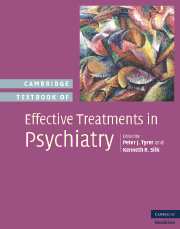Book contents
- Frontmatter
- Contents
- List of contributors
- Preface
- Part I Introduction
- Part II Summary of treatment modalities in psychiatric disorders
- 3 A critical assessment of methods and processes used to develop psychiatric drug treatments
- 4 Section I – The efficacy and safety of electroconvulsive therapy
- 4 Section II – Focal brain stimulation approaches to psychiatric treatment
- 5 The effectiveness of psychological treatments in psychiatry
- 6 Educational interventions
- 7 Complementary and alternative medicine
- 8 Complex interventions
- Part III Specific treatments
- Appendix I Summary of specific drugs having evidence of effectiveness in mental disorders
- Appendix II Key to effectiveness tables
- Index
- References
3 - A critical assessment of methods and processes used to develop psychiatric drug treatments
from Part II - Summary of treatment modalities in psychiatric disorders
Published online by Cambridge University Press: 12 May 2010
- Frontmatter
- Contents
- List of contributors
- Preface
- Part I Introduction
- Part II Summary of treatment modalities in psychiatric disorders
- 3 A critical assessment of methods and processes used to develop psychiatric drug treatments
- 4 Section I – The efficacy and safety of electroconvulsive therapy
- 4 Section II – Focal brain stimulation approaches to psychiatric treatment
- 5 The effectiveness of psychological treatments in psychiatry
- 6 Educational interventions
- 7 Complementary and alternative medicine
- 8 Complex interventions
- Part III Specific treatments
- Appendix I Summary of specific drugs having evidence of effectiveness in mental disorders
- Appendix II Key to effectiveness tables
- Index
- References
Summary
Editor's note
While the double-blind, placebo-controlled randomized clinical trial (RCT) has become the gold standard, and while many of the data behind the determination of effectiveness of compounds or other treatments in this volume rely upon the RCT as the primary determinant of effectiveness, this chapter reminds us that the gold standard is probably made up of less pure gold than we would want to believe. The variables, assumptions and biases that are inherent in the RCT and in Cochrane reviews and other meta-analyses are described in this chapter. The goal of Arana and Nutt is not to make sceptics of us all. Rather it is to make us wiser consumers of the psychiatric, particularly the pharmacologic psychiatric, literature so that we may approach both the literature and our patients with better understanding as to how to appreciate their illnesses and the benefits and limitations of the agents we have at our disposal in providing treatment to them.
Introduction
This chapter seeks to describe in simple terms the models and methods used to identify, test and validate the efficacy and safety of drugs for use in psychiatric illnesses.
In the first section, we review the complexity inherent in an environment where three strong, related, yet independent vectors drive most of the discovery in new drug development: (1) the profit motive of large pharmaceutical firms; (2) the academic motive evident in university settings where much of the preclinical and clinical research is undertaken; and (3) the clinical motive that seeks to offer relief to patients.
- Type
- Chapter
- Information
- Cambridge Textbook of Effective Treatments in Psychiatry , pp. 47 - 56Publisher: Cambridge University PressPrint publication year: 2008

